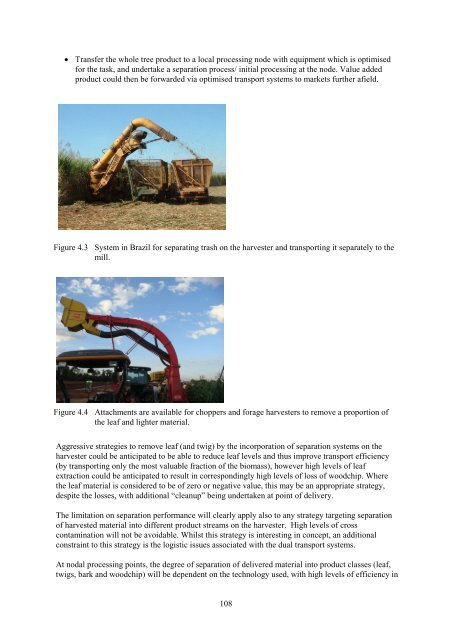Download (4Mb) - USQ ePrints - University of Southern Queensland
Download (4Mb) - USQ ePrints - University of Southern Queensland
Download (4Mb) - USQ ePrints - University of Southern Queensland
You also want an ePaper? Increase the reach of your titles
YUMPU automatically turns print PDFs into web optimized ePapers that Google loves.
• Transfer the whole tree product to a local processing node with equipment which is optimised<br />
for the task, and undertake a separation process/ initial processing at the node. Value added<br />
product could then be forwarded via optimised transport systems to markets further afield.<br />
Figure 4.3 System in Brazil for separating trash on the harvester and transporting it separately to the<br />
mill.<br />
Figure 4.4 Attachments are available for choppers and forage harvesters to remove a proportion <strong>of</strong><br />
the leaf and lighter material.<br />
Aggressive strategies to remove leaf (and twig) by the incorporation <strong>of</strong> separation systems on the<br />
harvester could be anticipated to be able to reduce leaf levels and thus improve transport efficiency<br />
(by transporting only the most valuable fraction <strong>of</strong> the biomass), however high levels <strong>of</strong> leaf<br />
extraction could be anticipated to result in correspondingly high levels <strong>of</strong> loss <strong>of</strong> woodchip. Where<br />
the leaf material is considered to be <strong>of</strong> zero or negative value, this may be an appropriate strategy,<br />
despite the losses, with additional “cleanup” being undertaken at point <strong>of</strong> delivery.<br />
The limitation on separation performance will clearly apply also to any strategy targeting separation<br />
<strong>of</strong> harvested material into different product streams on the harvester. High levels <strong>of</strong> cross<br />
contamination will not be avoidable. Whilst this strategy is interesting in concept, an additional<br />
constraint to this strategy is the logistic issues associated with the dual transport systems.<br />
At nodal processing points, the degree <strong>of</strong> separation <strong>of</strong> delivered material into product classes (leaf,<br />
twigs, bark and woodchip) will be dependent on the technology used, with high levels <strong>of</strong> efficiency in<br />
108
















